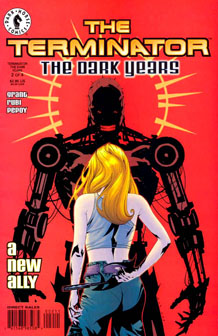“The Dark Years” (1999) is the most inaccurately titled series of the “Terminator” saga so far. The title calls to mind times of hopelessness and misery, but the art by Mel Rubi (pencils), Bob Wiacek (inks) and David Stewart (colors) is vibrant and energetic and the story by Alan Grant is about as lighthearted as this material gets.
Despite the fact that the four-issue “Dark Years” features John and Sarah more prominently than “Death Valley” – where they are essentially maguffins – I loved the grit and dark humor of that story and found this follow-up to be shallow. It’s hard to believe they come from the same writer. At least the quick back-and-forth between present day and Future War scenes makes it a brisk, painless read.
CHARACTERS
John Connor: John, 15, has his first encounter with a Terminator in this timeline, having been split up from his mom, who is hospitalized in the initial encounter. Meanwhile, John, 46, leads the resistance in 2030 and has a beard and none of the facial scars from the “T2” timeline.
Sarah Connor: She thinks the crowds of New York City on New Year’s Eve will be a safe enough place for her and John. She’s wrong. As with “Death Valley,” she doesn’t have the hard edge of the “T2” timeline’s Sarah. In the Future War of “The Dark Years,” Sarah is presumably deceased.
Kyle Reese: Dead during the 1999 scenes and unmentioned in the 2030 scenes.
Jon Norden: The kid from “Death Valley” has harbored a hatred of John Connor for 32 years because a Terminator that was hunting John killed Norden’s dad. So he punches John upon meeting him.
Selena: This resistance member is actually a brainwashed Skynet plant. Her identity is obvious from her first appearance being dropped off by a Skynet aircraft, but for some reason Grant plays the traitor’s identity as a mystery.
TERMINATORS
Big Apple T-800: It emerges in New York City on New Year’s Eve 1999, pretty much right on top of John and Sarah. It believes it has killed Sarah (John tricks it by changing the hospital records), then it pursues John, who kills it.
Rat spy robot: Not exactly a Terminator, but more of a spy device.
Brainwashed humans: Again, not exactly Terminators, but effective weapons nonetheless. I guess they’re like Marcus Wright and Dudley, but no cyborg half is necessary because the brainwashing works well enough.
CONTINUITY
In the present-day scenes, “The Dark Years” picks up after “Death Valley,” on New Year’s Eve 1999, with the calendar about to turn to Y2K (wrongly labeled “the new millennium,” as the writer makes the common mistake of thinking 2000 is the first year of the third millennium rather than the last year of the second).
In the Future War scenes, the action picks up in 2030, with the war still going on. This marks at least the second timeline where we’ve seen the war continue past the resistance’s traditional year of victory in 2029. The other was the Now Comics timeline. The Malibu Comics timeline also hinted at a continuing war at the end of its narrative.

The letters column in Issue 4 explicitly states what I surmised from “Death Valley”: This second string of Dark Horse stories takes place on a distinct timeline from all previous stories except the first movie. Editor Mike Hansen says of the previously published stories:
“History – and the future – has rewritten itself so that these stories do not currently ‘exist.’ … they all DID happen … so if you want to see what the future once was, go and check these stories out.”
That explanation contrasts slightly with my theory that “Death Valley”/”Dark Years” is on the FIRST new timeline created by the time travelers of the first movie.
The T-800 believes it has accomplished its “secondary objective” of killing Sarah. This is the same “secondary objective” the Terminators had in the series by that title. But in “Secondary Objectives,” the primary mission is protecting the birth of Skynet. Here, the primary mission is killing John.
The birth of Skynet was only briefly hinted at in “Death Valley” with the early versions of HK-Tanks (which were then destroyed), and the birth-of-Skynet thread is completely untouched here. I don’t blame Grant, as that ground has already been well trod. Still, it does make a reader wonder if J-Day is going to occur anytime soon on this timeline.
The resistance’s hidey-holes are back to the rough-and-tumble look after the military spit-shine of “Nuclear Twilight.”
TIME TRAVEL
We learn about a TDE in New York City. A T-800 pops up on New Year’s Eve 1999 pretty much right on top of John and Sarah. We’re not told in this story how Skynet knows they will be there.
Evidence for “fate”:
- As pre-ordained, John is the resistance leader.
Evidence that “the future is not set”:
- It’s now 2000 in the present-day narrative, and there is still no Judgment Day – or any hints of Skynet’s formative phase — on this timeline.
- It’s 2030 in the Future War, and it’s suggested that John did not send Kyle back in a TDE bubble in 2029. John narrates: “Sarah impressed upon him that only he could save mankind. She didn’t say how.” That would be an odd statement if John did indeed do his fated duty of sending back Kyle in 2029. So how is John still here if he was never born? A couple of possibilities: 1) I’m reading too much into the statement, and he did indeed send Kyle back. What he means by the statement is that he doesn’t know the specifics of how to win the war. Or 2) He hasn’t sent Kyle back yet, but he doesn’t have to do so in the exact same way as the previous history. Maybe TDEs are developed later in this timeline, just as J-Day happens later.

